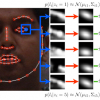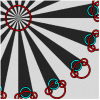ICCV
2009
IEEE
15 years 4 months ago
2009
IEEE
Local experts have been used to great effect for fitting deformable
models to images. Typically, the best location in
an image for the deformable model’s landmarks are found
t...
ICCV
2009
IEEE
15 years 4 months ago
2009
IEEE
Unsupervised over-segmentation of an image into superpixels
is a common preprocessing step for image parsing
algorithms. Superpixels are used as both regions of support
for feat...
ICCV
2009
IEEE
15 years 4 months ago
2009
IEEE
This paper presents a novel method for detecting scale
invariant keypoints. It fills a gap in the set of available
methods, as it proposes a scale-selection mechanism for
juncti...
ICCV
2009
IEEE
15 years 4 months ago
2009
IEEE
Deformable model fitting has been actively pursued in the computer vision
community for over a decade. As a result, numerous approaches have
been proposed with varying degrees of...
ICCV
2009
IEEE
15 years 4 months ago
2009
IEEE
We present a vision-based method that assists human
navigation within unfamiliar environments. Our main contribution
is a novel algorithm that learns the correlation between
use...
ICCV
2009
IEEE
15 years 4 months ago
2009
IEEE
This paper presents a method to quantitatively evaluate
information contributions of individual bottom-up and topdown
computing processes in object recognition. Our objective
is...
ICCV
2009
IEEE
15 years 4 months ago
2009
IEEE
We propose a novel approach for multi-person trackingby-
detection in a particle filtering framework. In addition
to final high-confidence detections, our algorithm uses the
con...
ICCV
2009
IEEE
15 years 4 months ago
2009
IEEE
It has recently been shown that deformable 3D surfaces
could be recovered from single video streams. However, ex-
isting techniques either require a reference view in which
the ...
ICCV
2009
IEEE
15 years 4 months ago
2009
IEEE
2D Active Appearance Models (AAM) and 3D Morphable
Models (3DMM) are widely used techniques. AAM
provide a fast fitting process, but may represent unwanted
3D transformations un...
ICCV
2009
IEEE
15 years 4 months ago
2009
IEEE
A general framework simultaneously addressing pose
estimation, 2D segmentation, object recognition, and 3D
reconstruction from a single image is introduced in this
paper. The pr...


